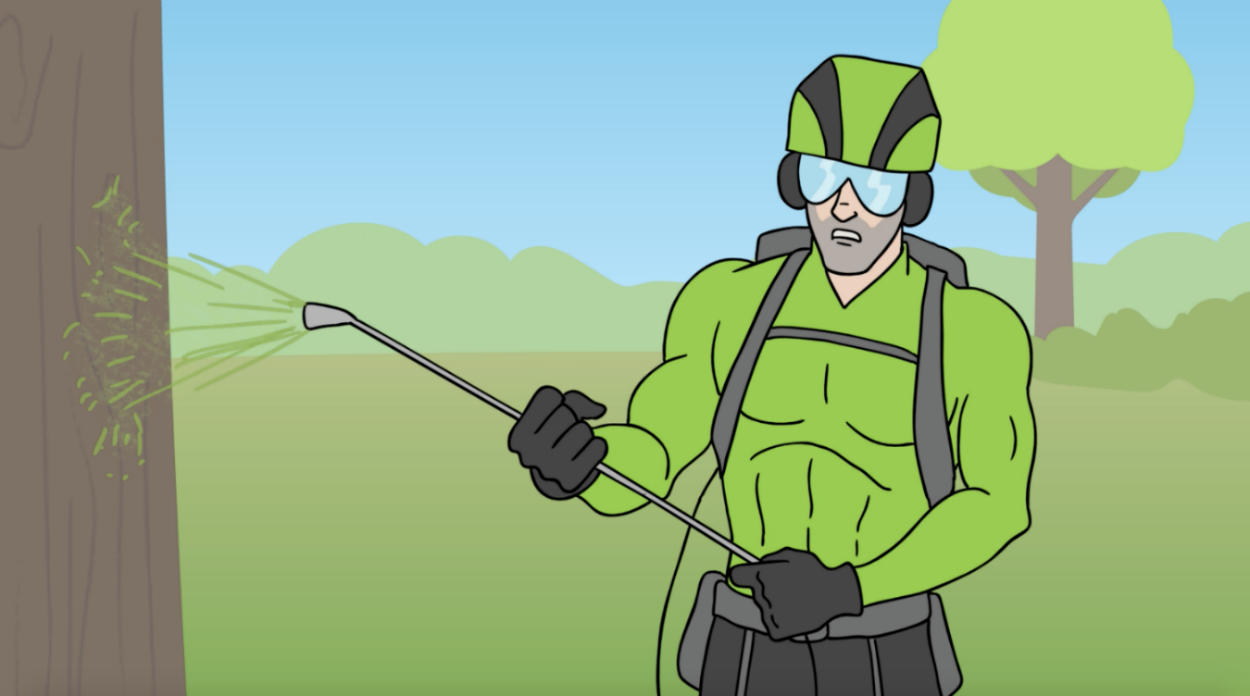
Emerald Ash Borer Treatment Option: Bark Spray
Smart Ash’s Note: If it’s detailed information about emerald ash borer trunk injection treatments you want, you’ve come to the right place. If you want higher-level, more actionable information about your options as an ash tree owner, visit our emerald ash borer treatment page.
EAB bark sprays come in two forms: noninvasive, systemic basal trunk sprays and protective cover sprays. Dinotefuran is labeled for application as a noninvasive, systemic basal trunk spray for EAB control. It belongs to the same chemical class as imidacloprid (neonicotinoids) but is much more water soluble and moves more readily through plants. Products that have been evaluated as cover sprays for control of EAB include some specific formulations of permethrin, bifenthrin, cyfluthrin and carbaryl.
Noninvasive, systemic basal trunk sprays are formulated insecticide sprayed on the lower five to six feet of the trunk using a common garden sprayer and low pressure. Research has shown that the insecticide penetrates the bark and is transported systemically throughout the tree. This application technique does not wound the tree, and when applied correctly, the insecticide does not enter the soil.
Protective cover sprays can be sprayed on the trunk, branches and (depending on the label) foliage to kill adult EAB as they feed on ash leaves, and newly hatched larvae as they chew through the bark. Protective cover sprays are designed to control EAB adults and perhaps very young larvae that have just hatched from eggs, and will have no effect on larvae feeding under the bark.
Noninvasive, systemic basal trunk sprays: Studies to date indicate that the effectiveness of dinotefuran basal trunk sprays are similar to soil drench treatment applications of dinotefuran or imidacloprid, which is to say that its efficacy rates are inconsistent largely because, even among researchers, application protocols vary considerably and are difficult to replicate, making it equally difficult to reach firm conclusions about efficacy.
Michigan State University (MSU) and Ohio State University (OSU) studies have evaluated residues in leaves from trees treated with the noninvasive, systemic basal trunk spray. Results show that the dinotefuran effectively moved into the trees and was translocated to the canopy at rates similar to those of other trunk-injected insecticides, and faster than other soil-applied neonicotinoid products. In an MSU study conducted in 2007 and 2008, annual dinotefuran trunk sprays reduced EAB larval density by approximately 30 to 60 percent compared to the heavily infested untreated trees. As with dinotefuran and imidacloprid soil applications, the noninvasive, systemic basal trunk treatment was effective for only one year and would have to be applied annually. In a five-year OSU study with trees up to 22 inches in diameter at breast height (DBH), dinotefuran basal bark sprays provided effective protection when applied at the highest labeled rate (average of less than 5% canopy decline compared with nearly 80% average canopy decline for untreated trees). A lower rate was not as effective (almost 20% average canopy decline).
Protective cover sprays: Studies to date on protective cover sprays have been similarly inconclusive on efficacy when compared to noninvasive, systemic basal trunk sprays. MSU studies have shown that applications of OnyxTM, Tempo® and Sevin® SL provided good control of EAB, especially when the insecticides were applied in late May and again in early July. Acephate sprays were less effective. BotaniGard® (Beauvaria bassiana) was also ineffective under high pest pressure.
In another MSU study, spraying Tempo® just on the foliage and upper branches or spraying the entire tree were more effective than simply spraying just the trunk and large branches. This suggests that some cover sprays may be especially effective for controlling EAB adults as they feed on leaves in the canopy. But sprays must be well-timed and expertly applied to be effective, and two sprays may provide extra assurance given the long period of adult EAB activity.
Garden sprayers used to apply systemic basal trunk sprays must be calibrated to ensure the appropriate amount of the formulated product is applied to each tree. Dinotefuran can be mixed with surfactants that may facilitate its movement into the tree, particularly on large trees with thick bark. However, in field trials, adding a surfactant did not consistently increase the amount of insecticide recovered from the leaves of treated trees or improve the effectiveness of the application.
Protective cover sprays should be timed to occur when most adult beetles have emerged and are feeding on ash leaves. For best results, consider two applications, one at 500 DD50 (as black locust approaches full bloom) and a second spray four weeks later. It should also be noted that spraying large trees is likely to result in a considerable amount of insecticide drift, even when conditions are ideal. Drift and potential effects of insecticides on non-target organisms should be considered when selecting options for EAB control.
This information was adapted from a multi-state study on emerald ash borer insecticides performed by Colorado State, Ohio State, Michigan State and Purdue universities. So which EAB treatment method is the best for ash trees in Metro Denver, an area that includes 1.45 million ash trees? Unfortunately, there isn’t one right answer.
The best treatment for your Denver ash depends on a variety of factors, and is ultimately dependent on property owner preference. While some experts might not recommend treating your ash tree before EAB is found in Denver, it is worth noting that it may take three years for your tree to show obvious signs of infestation. And by then, it may be too late to save. Before making any decisions, you should consult multiple sources. This list of Certified Smart Ashes, all of whom are licensed by the Colorado Department of Agriculture to apply pesticides, is a great place to start.
